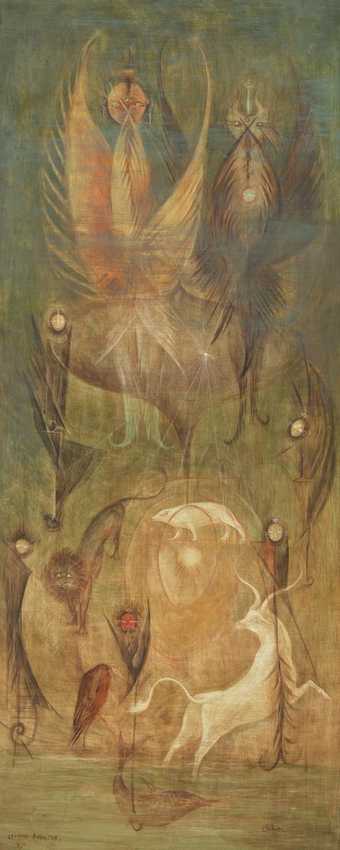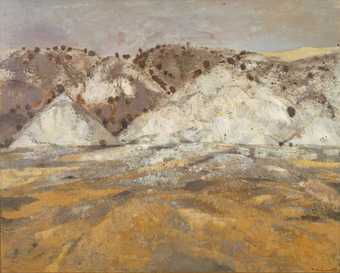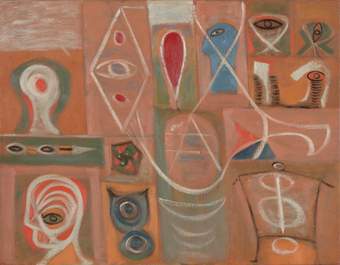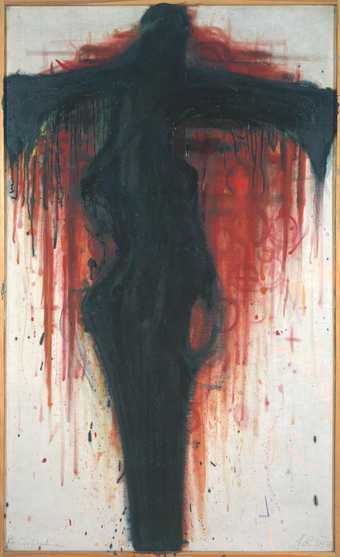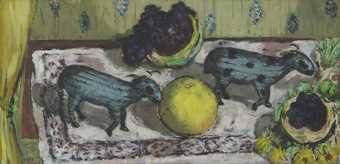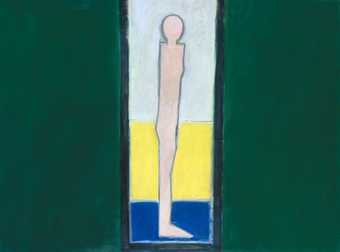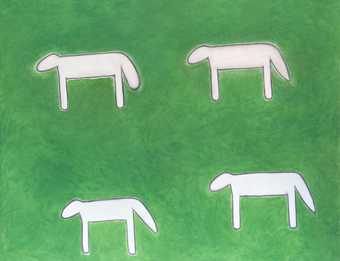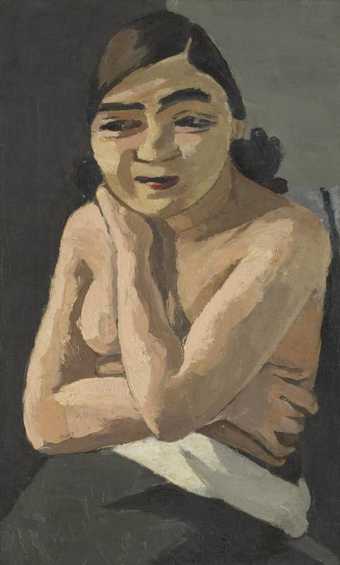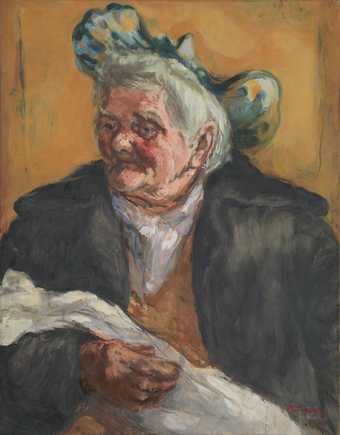
In Tate St Ives
- Artist
- Wolfgang Paalen 1905–1959
- Original title
- Le Messager
- Medium
- Oil paint on canvas
- Dimensions
- Support: 2000 × 765 mm
frame: 2139 × 907 × 74 mm - Collection
- Tate
- Acquisition
- Bequeathed by Mrs Jacqueline Marie Onslow-Ford 1979
- Reference
- T02392
Catalogue entry
T02392 LE MESSAGER (The Messenger) 1941
Inscribed ‘W/P41’ bottom right
Oil on canvas, 78 1/4 × 30 1/4 (198.8 × 76.7)
Bequeathed by Mrs Jacqueline Marie Onslow Ford 1979
Prov: Mr and Mrs Gordon Onslow Ford, Erongarícuaro, Mexico, and Inverness, California (purchased from the artist c.1941)
Exh: Homenaje a Wolfgang Paalen el Precursor, Museo de Arte Moderno, Bosque de Chapultepec, Mexico, September–October 1967 (8)
Lit: Gordon Onslow-Ford, ‘Paalen the Messenger’ in Hommage to Wolfgang Paalen, Museo de Arte Moderno, Bosque de Chapultepec, Mexico, 1967, pp.25–6,. repr. n.p. in colour
Gordon Onslow Ford wrote of this work in a note of August 1979: '“The Messenger” is one of the first paintings that Wolfgang Paalen made at his home at San Angel Inn, on the outskirts of Mexico City. This painting was an abrupt change from his previous work in Europe. As a member of the Surrealist Group he invented the automatic technique of Fumage (painting with smoke from a lighted candle into a ground of wet paint). Fumage was a means to evoke images of dream, wish and myth on the canvas that might otherwise have remained dormant. In Mexico, Paalen's preoccupations turned away from the romantic and towards pragmatic philosophies of the USA, Modern Science and Amerindian Art.
'While “The Messenger” was being painted, the first number of Paalen's magazine DYN was in preparation with a leading article entitled: “Farewell to Surrealism”, which, when it came out in 1942, took the Surrealists in New York City completely by surprise.
'Paalen's studio was built around a Tlingit masterpiece that he had acquired in the Pacific North West. It was a wooden totem screen, 15' × 9', from a community house. The screen represented a brown bear (it is now in the Denver Art Museum). The bear had eyes and faces staring from the joints, paws and head and there was a hole in the body through which in certain ceremonies the chief and initiates emerged (being born). This Earth-Mother Bear was a powerful influence in the studio and may have engendered the leap of awareness that occurred in Paalen's painting.
' “The Messenger” is an apparition from deep space. He is made of the same stuff as space. Like most ghosts from the past or, in this case, from the future, he is silent; his message must be sought in the guise in which he appears. The painting is structured with rapid curved lines that have colours between them, playing hot and cold to accentuate an endless, undulating surface with occasional protrusions.
' “The Messenger” flies-floats in his ocean of space-matter; his world goes with him as he goes. He stops those who SEE him in their tracks, and once seen, he can never be forgotten. The white egg shaped face has an air of concentration. He is dedicated to his mission. The eyes are paraboloid. They touch the lips and are focused far away as if they are receiving and transmitting. Their lines of sight extend on each side of the observer; who is drawn in and ignored at the same time.
'The painting is a presage of man's first walk in space, 28 years later. This painting was titled “Le Messager” (masculine), but the apparition could be seen as being androgynous. It might be of interest to note that the Androgyne appears on Tarot card number 21 of the original Marseilles pack. If the major arcana numbered 1 to 22 symbolise the stages of awareness along the way to enlightenment, then the Androgyne is the final stage before union with the divine or, from another point of view, the root of Being in the Mind.
' “The Messenger” shows us his space-body and may be reminding us that our bodies too are made up of cosmic material, and that, if only we could realise it, we are, in our flesh and bones, already in relation to the heavens.
‘Paalen's Messenger comes to awaken us to the urgent need for a quest in space both inner and outer’.
Paalen's other paintings of this period and type have titles such as ‘Space Unbound’, ‘Aerogyl Prismatic’ and ‘The Cosmogons’, and there is an etching of 1941 which is very similar to the present work and has the same title.
Published in:
The Tate Gallery 1978-80: Illustrated Catalogue of Acquisitions, London 1981
Explore
- abstraction(8,615)
-
- from recognisable sources(3,634)
-
- figure(2,270)
- magic and occultism(206)
-
- ghost(80)
- spirituality(739)
You might like
-
Leonora Carrington Eluhim
1960 -
Henry Inlander Sienese Hills
1956 -
Francis Bacon Study for Portrait II (after the Life Mask of William Blake)
1955 -
Adolph Gottlieb The Alchemist
1945 -
Arnulf Rainer Wine Crucifix
1957–78 -
Marie-Louise Von Motesiczky Still Life with Sheep
1938 -
Peter Kinley Figure in a Doorway
1967 -
Peter Kinley Four Sheep
1970 -
Marie-Louise Von Motesiczky Model, Vienna
1930 -
Marie-Louise Von Motesiczky Old Woman, Amersham
1942

